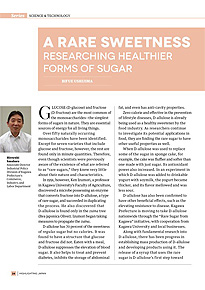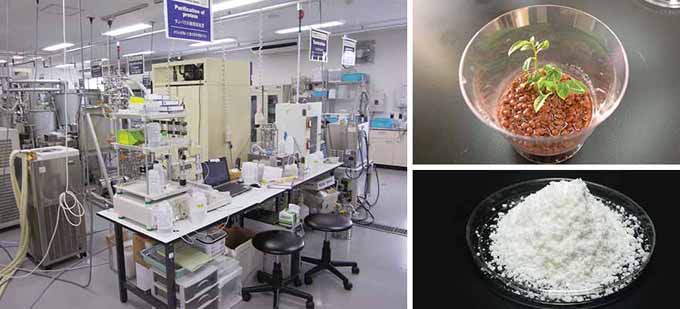Home > Highlighting JAPAN >Highlighting Japan September 2014>Science & Technology
Highlighting JAPAN

Science & Technology
A Rare Sweetness
Researching Healthier Forms of Sugar

G LUcose (D-glucose) and fructose (D-fructose) are the most common of the monosaccharides—the simplest forms of sugars in nature. They are essential sources of energy for all living things.
Over fifty naturally occurring monosaccharides have been identified. Except for seven varieties that include glucose and fructose, however, the rest are found only in minute quantities. Therefore, even though scientists were previously aware of the existence of what are referred to as "rare sugars," they knew very little about their nature and characteristics.
In 1991, however, Ken Izumori, a professor in Kagawa University's Faculty of Agriculture, discovered a microbe possessing an enzyme that converts fructose into D-allulose, a type of rare sugar, and succeeded in duplicating the process. He also discovered that D-allulose is found only in the zuina tree (Itea japonica Oliver). Izumori began taking measures to propagate the zuina.
D-allulose has 70 percent of the sweetness of regular sugar but no calories. It was found to have a structure that glucose and fructose did not. Eaten with a meal, D-allulose suppresses the elevation of blood sugar. It also helps to treat and prevent diabetes, inhibits the storage of abdominal fat, and even has anti-cavity properties.
Zero-calorie and effective in the prevention of lifestyle diseases, D-allulose is already being used as a healthy sweetener by the food industry. As researchers continue to investigate its potential applications in food, they are finding the rare sugar to have other useful properties as well.
When D-allulose was used to replace some of the sugar in sponge cake, for example, the cake was fluffier and softer than one made with just sugar. Its antioxidant power also increased. In an experiment in which D-allulose was added to drinkable yogurt with soymilk, the yogurt became thicker, and its flavor mellowed and was less sour.
D-allulose has also been confirmed to have other beneficial effects, such as the elevating resistance to disease. Kagawa Prefecture is moving to take D-allulose nationwide through the "Rare Sugar from Kagawa" initiative, with cooperation from Kagawa University and local businesses.
Along with fundamental research into D-allulose, there has been progress in establishing mass production of D-allulose
and developing products using it. The release of a syrup that uses the rare sugar is D-allulose's first step toward commercialization. Since major manufacturers have begun releasing products that use this syrup, rare sugar has made a name for itself throughout Japan.
"There is already something of a mass-production system in place for D-allulose, and it has already passed food safety standards," says Hiroyuki Sasahara, who works in the Industrial Policy Division of Kagawa Prefecture's Commerce, Industry, and Labor Department to industrialize rare sugar. "It is now going through the application process to become a designated health food, and if approved it will likely be used in an even wider range of foods and beverages."
Kagawa Prefecture is home to many diabetes patients. In fact, it ranks first in Japan in the estimated number of diabetes patients receiving medical treatment with approximately a hundred thousand such residents. The prefecture hopes to reduce its number of diabetes cases through the use of rare sugars.
Besides D-allulose, Kagawa University has succeeded in creating the rare sugar D-allose. D-allose has an antioxidizing effect, which has led to high hopes for the sugar's applications in the medical field.
Of the over fifty varieties of rare sugars, only D-allulose and D-allose are currently being commercially manufactured, but they are already producing marvelous results. From Kagawa to all of Japan, and then to the entire world: as the usefulness and functionality of rare sugars become clearer, their sweet potential will continue to grow.
© 2009 Cabinet Office, Government of Japan






